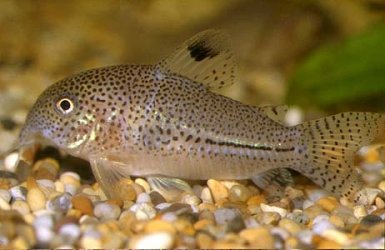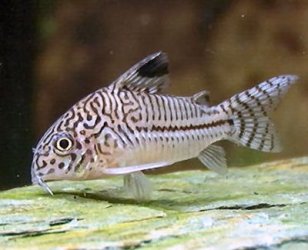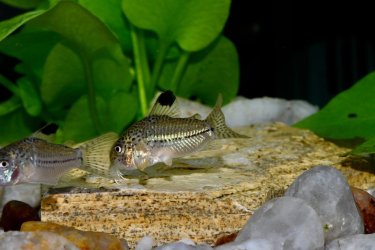Wow they are so cute. You could almost miss them, tiny things
🌟 Exclusive Amazon Black Friday Deals 2024 🌟
Don’t miss out on the best deals of the season! Shop now 🎁
You are using an out of date browser. It may not display this or other websites correctly.
You should upgrade or use an alternative browser.
You should upgrade or use an alternative browser.
Little update on my tank
- Thread starter Lcc86
- Start date
Are C. trilineatus also farm bred or more wild caught, or 50/50 ? Also, why do you think shops mis-label them so much? Just similar looking?Byron is more knowledgeable about cories than me, so take his advice if it's different from mine.
5 should be enough as there are other cory species in the tank, but more would be better. And they are probably not juliis. The fish sold as juliis in shops are really C. trilineatus. It doesn't matter much as they have the same needs, just something to be aware of
These are the seriously fish profiles for each @Lcc86 I think many of here rate the seriously fish information
Corydoras trilineatus (Three-lined Cory) — Seriously Fish
Corydoras julii – Julii Cory — Seriously Fish
@Byron @Essjay wonder if I could pick your brains on my cories. I have 5 julii cories (3 adults, 2 juveniles), 3 pandas (did buy 5 but 2 died straight away) and 12 pygmies. The pandas and pygmies are always out and about quite happily either alone or in a group, but the julii seem more shy, especially the adults. Is this a "personality trait" of julii cories? I can always add a few more soon but wasn't sure if it would make a noticeable difference. Or is there anything else I can do in terms of tank setup to help them come out more?
I do not know if C. julii (or C. trilineatus, whichever) are more shy than others. I have had around 15 species over the years, and some are certainly out more than others. I wouldn't worry about this. As for more cories, a few more panda are advisable. In my experience, this is a species that does like to be in groups of its own, more than many other species I have kept. I would get 2 or 3 more (shame the 2 died, that would have been OK with the five).
Here are photos of C. julii, C. trilineatus, and wild caught C. julii which to me are different from the first photo. Ian Fuller says the wild ones are C. julii, they were captured in the Rio Granjeiro in NE Brazil. [C. trilineatus by contrast occurs in SE Peru, half a continent away.]
Attachments
Are C. trilineatus also farm bred or more wild caught, or 50/50 ? Also, why do you think shops mis-label them so much? Just similar looking?
These are the seriously fish profiles for each @Lcc86 I think many of here rate the seriously fish information
Corydoras trilineatus (Three-lined Cory) — Seriously Fish
www.seriouslyfish.com
Corydoras julii – Julii Cory — Seriously Fish
www.seriouslyfish.com
So far as I know, from Ian Fuller's posts on Corydoras World, C. julii will be wild caught. And very rare. These are native to streams in NE Brazil, so knowing that is where they come from usually answers the species question. Patterns on most Corydoras can be variable, so the source is an important factor.
C. trilineatus I do not know if they are solely wild. Most of the "julii" cories in the hobby are in fact C. trilineatus. I cannot remember how this mix-up occurred, Ian has mentioned it but I've forgotten.
The pattern is usually different enough to be seen. This excerpt from my profile of C. julii explains it.
This is one of four very similarly-patterned corys that are frequently confused and will often be seen in stores under incorrect names. Corydoras julii, C. leopardus, C. punctatus and C. trilineatus all share a large black blotch in the dorsal fin, a barred caudal fin, and a horizontal stripe along the body at the juncture of the dorsal and ventral lateral plates; the body is spotted. However, all these species are highly variable in their pattern, and the horizontal stripe may be absent in C. julii.
The subject species (C. julii) is quite rare in the hobby, since it occurs in rivers and areas that are generally not heavily-fished commercially and is therefore seldom exported; the few times it does appear it has probably been collected in the Rio Para which is regularly fished. The "Julii" cory most often seen in stores is more likely to be C. trilineatus. The true C. julii has a spotted pattern on the head and body, and the lateral stripe is either not present or extends only midway along the body. C. julii is also somewhat smaller and more compact-looking in size than C. trilineatus.
The subject species (C. julii) is quite rare in the hobby, since it occurs in rivers and areas that are generally not heavily-fished commercially and is therefore seldom exported; the few times it does appear it has probably been collected in the Rio Para which is regularly fished. The "Julii" cory most often seen in stores is more likely to be C. trilineatus. The true C. julii has a spotted pattern on the head and body, and the lateral stripe is either not present or extends only midway along the body. C. julii is also somewhat smaller and more compact-looking in size than C. trilineatus.
C. trilineatus usually has a reticulated head pattern and the body markings are more variable than C. julii which always has a spotted head and body and is somewhat smaller and more compact-looking in size.
They're pretty cool, I like the way they just rest and chill out like that.Wow they are so cute. You could almost miss them, tiny things
Of the three pictures my three adults look most similar to the first picture but a bit paler I would say with very dense spots on their faces.I do not know if C. julii (or C. trilineatus, whichever) are more shy than others. I have had around 15 species over the years, and some are certainly out more than others. I wouldn't worry about this. As for more cories, a few more panda are advisable. In my experience, this is a species that does like to be in groups of its own, more than many other species I have kept. I would get 2 or 3 more (shame the 2 died, that would have been OK with the five).
Here are photos of C. julii, C. trilineatus, and wild caught C. julii which to me are different from the first photo. Ian Fuller says the wild ones are C. julii, they were captured in the Rio Granjeiro in NE Brazil. [C. trilineatus by contrast occurs in SE Peru, half a continent away.]
My LFS hasn't had pandas in again since I got these ones or I would've grabbed 2 more by now, I'll keep looking!
Nuttawet
Fish Crazy
I have those skull as a decoration too, i hope i can show on contest some times.
Similar threads
- Replies
- 2
- Views
- 423





